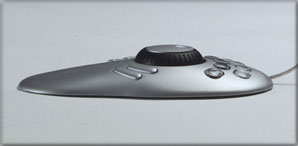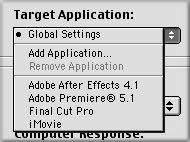
Hardware Review Feburary 11, 2001
Shuttle PRO Multimedia Controller
Contour Design's Shuttle Pro Multimedia Controller
$99.95
Review by Charles Roberts
Frankly, I was Skeptical:
I've been cutting video for a long time. I've used linear tape-to-tape systems as well as digital non-linear editors and I've gotten used to adapting to whatever workspace the system I'm using allows me. In general, that's usually pretty restrictive. Linear systems follow the venerable system of Jog and Shuttle wheels that make the tape transports on the tape decks leap to life. Digital non-linear editors, like Avid, Media 100, Premiere and Final Cut Pro use mouse-driven, or if you get lucky (and spend enough money), keyboard patterns that sort of mimic the hand-eye coordination system that Jog/Shuttle provides for physical tape decks.

Nearly every digital video editor incorporates a tape transport metaphor into their interface design. Play, Rewind, Fast-Forward, etc. are all standards that hearken back to a day when push buttons engaged gears that drove motors and caused action. We humans are hardwired for our tools and we can't live without them. Now that the physical gears are gone, we still need to see the veneer of gears to intuit what something can do. And so Avid, Media 100, Premiere and Final Cut Pro still put funny little buttons with arrows on the windows of their onscreen editors, much to the disgruntlement of every editor's wrist.All is not lost, though. For years, Apple has been fantastic about the development of keyboard support, and the subsequent ease of including keyboard shortcuts in third party software. You can usually tell how long someone has been using a Mac by how many keyboard shortcuts they use and how many times they reach for the mouse. Sometimes I have to bite my finger to keep from grabbing the mouse from a student and tossing it out the window.
Pretty early on, software developers instituted what is called 'J-K-L' support. It simply uses the QWERTY keyboard's J, K and L keys as respectively Rewind, Pause and Fast Forward. Many applications have followed this lead, and each application has developed its own variation on important other related keystrokes. Take for example our friend Final Cut Pro, where J-K-L support was finally added last year, after tremendous user clamoring. Just above the J-K-L keys are located the I and O keys, or the Final Cut Pro keyboard shortcuts for In and Out. Using these five keys together with one hand, it is possible to log clips and whole tapes without touching the mouse or looking at the keyboard (even for non-typers like me who skipped typing in high school and have regretted it ever since.) Its just another one of those innovations that combines the conventionality we humans have come to expect from machines since the Industrial Revolution with the need to forget that we are using a convention at all so that we can get some freaking work done!!!
For the compositor and anyone else using applications other than a chosen digital editor, there is an inherent problem here. Things like J-K-L support are conventionally related to physical decks and applications that directly access them. Thus you can expect to see Avid, Media 100, Premiere or Final Cut Pro adopting these transport keyboard shortcut conveniences. But what about other applications that do not capture video from an outside source like a deck? Although many applications use keyboard shortcuts for speeding up navigation on a linear timeline, few offer robust solutions such as J-K-L support. Adobe's After Effects, Pinnacle's Commotion, Digidesign's Protools, Macromedia's Flash all offer proprietary shortcuts, but not the quasi-universal keyboard-based tape transport metaphor that many editors crave.
Now, what if you had a little device that treated each software application as a tape deck, complete with Jog/Shuttle control for variable speed? What if this device also was so flexible that it could support nearly any application that offered keyboard shortcuts of any kind? And what if it contained programmable buttons for the application functions that could not directly take advantage of the tape transport metaphor? You'd be looking at Contour Design's new ShuttlePro USB multimedia controller.
Like the header of this review states, I was pretty skeptical at first. There's a certain arrogance that comes with the internalization of the keyboard shortcut system for any application. My first reaction was, "Why on earth would anybody take bread off of the table to perform a function that they could just as simply do by moving their hands five inches to the left and their eyes not one iota?" I gotta admit, I was ready to pan this device as a relative of the TV remote control, a device that allows us to expend less energy while surfing channels faster, though we still end up watching the same drek.
Of course, ten minutes after getting it set up and having tested my second application with it, I was hooked and had completely forgotten about my raging class warfare against the obscene luxury of the Jog/Shuttle. There's no denying that the Jog/Shuttle is even more natural than J-K-L support on a keyboard, because the springiness of the controller is actually programmed for tension, allowing you to move at very precise speeds without re-clicking keys. The Jog/Shuttle spindle itself is pretty sturdy itself, and though its not the heavy plastic and rubber you'd expect on a 15,000 dollar edit controller for a deck, its seems hardy enough to be substitute for a mouse and keyboard, which is what it essentially is doing. The shape of the device is flat and wide, requiring more desktop space than you'd think, but also making the thing essentially unshakable and seemingly melt into the surface of your work area.
Very quickly, I found that, within Final Cut Pro, I was actually reaching for the keyboard very rarely and the mouse almost never. This is before I even opened the Control Panel and took a look at the presets for the 13 programmable keys that are included. Turns out that, in a very snappy process, you can preset those keys based on the keyboard shortcuts of the native application. The ones you use all the time, like Razor Blade, Open Project, Next Window, etc., essentially anything that has a shortcut, can live right next to the Jog/Shuttle spindle and you end up using the keyboard even less. Pretty snappy indeed.
The Control Panel comes with built-in the presets for Final Cut Pro, Premiere and Imovie. In addition, you can add any application as well as making global changes to all the applications' presets. For instance if you are a south paws, I'd assume you'd want to change nearly everything everywhere, so you'd globally alter all the buttons to positions more comfortable for you. It feels really unlimited.

In point of fact, it's a little TOO unlimited. Since the ShuttlePro is so adaptable across applications, the keys on the pad are unmarked clear plastic. But this makes it pretty danged difficult to remember what the second-row third-from-the-left button does in After Effects after you've been cutting in Final Cut Pro for a few hours. Of course, you could do what I immediately did and put a little color tape on the ones you really need to remember, but that's an ugly solution for such an elegant sleek little device. Contour Design would do well to consider adding color coding for the buttons or even adding raised relief symbols on them to facilitate memory of assigned function.
Setup was amazingly simple. The device doesn't even ship its drivers; you instead download a 270k installer from their website and go from there. No reboot is required, and you just crank up the application of choice and roll. It is a USB device, so you may want to look into acquiring a USB hub. Although, like your keyboard and mouse, it doesn't require a powered USB connection and it happily functions right off the second keyboard USB port opposite the mouse, you'll value the extra space a USB hub provides between your keyboard, mouse and shuttle as their specializations get more refined. Just don't tip too far back into the recliner!!!
One interesting problem that popped up in testing was in adding application presets for two different versions of the same application. I had two versions of After Effects on my system (4.0 and 4.1), but found that when I tried to add 4.0 to the list after 4.1, I was given an error message stating that a later version of the OS was required than 8.6. Of course I am running nothing less than 9.1 on that machine, so I'm not sure what happened. Still this is not much of a gripe. I do periodically utilize different versions of some applications, particularly ones that stupidly drop valuable features or for which projects are not compatible across versions. Whether or not this is specific to After Effects or my system is unclear, but if it is a bug in the driver, it might be wise to clear it up.
Finally, back to class warfare. The question really isn't whether the thing works. I'm satisfied with its reliability and workmanship. It jumped out of the box and onto my system with nary a squeak, and as I said, before I could catch myself I was tooling around my footage, both on tape and timeline, like a high school kid with a new drivers license. It's a nice little device. And its one of the few USB devices I've encountered that didn't cause extension conflicts immediately upon installation. Class act all the way.
But is it worth the 99.95 that it retails for? That might depend on who you are. Folks who work online with many hours of footage may find that this 100 bucks takes all the keyboard and mouse stress away with one swoop. You definitely feel a more physical connection with your footage when using a Jog/Shuttle device. The fact that it also commands a huge chunk of your most frequently accessed functions could be very liberating for these same people.
On the other hand, folks who don't work with large unruly portions of media or who use such a spread of applications that the presets become meaningless may find it as a shiny toy with little value. Given, there is nothing wrong with more input options in your editor, but people who operate with a mouse hand all the time for compositing reasons will probably find the two-fisted mouse/keyboard combo a better way to move around. Although the Shuttle Pro can easily function within any application, its usefulness may not manifest as definitively as it will with editors of long form work that are probably drooling on the screen right now.
So once again I'd say the answer depends on your needs. It could be the best thing you added to your system and $99.95 is very little to pay for speed and stress relief. But consumers aside, I have to give an A for effort, adaptability, simplicity of installation and functionality and a high B for design with regard to the button issues. It's a nice piece of work that I hope will improve on its own fantastic features in future versions. Like maybe adding a silicon chip to my forehead so that I can edit while asleep...
Charles Roberts (AKA Chawla) teaches Digital Video and Audio Production at Fitchburg State College in Fitchburg, MA. He uses his long tedious rendering times to generate content and tackle hard hitting issues on the discussion boards of 2 Pop (www.2-pop.com). His house seems to shrink with every passing day...